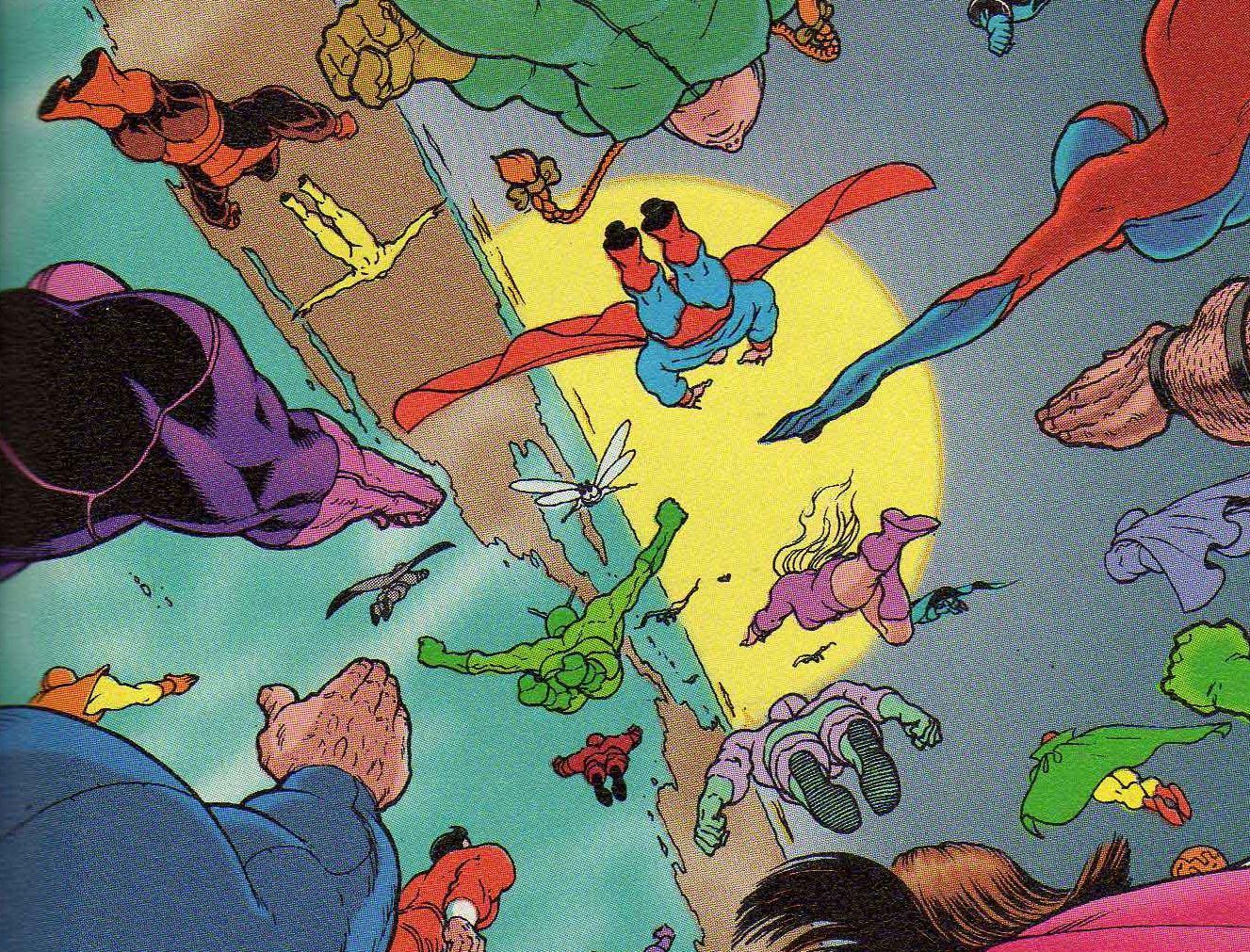The Complete History of Miss Mystery, Part Four: Enygma (1984-1988)

The mid-Eighties were a tumultuous time for the already-struggling Value Comics. Their parent company had just sold off numerous assets to stay afloat, their printers were having great difficulty acquiring green ink, and their two biggest competitors were beginning to advance in storytelling and art in ways Value simply didn’t intend to keep up with.
As tends to happen, it was decided that a line-wide shake-up was the best way to revitalize interest in a stable of characters who had been around in some form or another since the mid-50s. Cataclysm in Space had far-reaching effects on the VCU, even if it did ultimately fail to improve Value’s standing in the industry. In addition to some long-needed changes to the status quo of the line’s major characters, the event did much to streamline their oft-convoluted, frequently contradictory histories.
However, a number of characters not currently in the spotlight, including a number of fan-favorite characters whose heyday was either long past or not yet to come, fell through sizable cracks in this new foundation.
As we mentioned, it had been several years since Miss Mystery had carried her own title. Worse, the post-Cataclysm roster of the Wonder Warriors, now the company’s flagship comic, not only failed to include her, but was established as never having contained her. Her role in the Monstermind Wars, during which the team was founded, was retconned as having involved Shocking Pink instead, as her recently-launched solo title was a top seller for Value.
In the bold new VCU of Cataclysm, Miss Mystery’s status was uncertain. Did she even exist? For almost a year, we had no idea. Her pulp-tinged style was deemed inconsistent with the new tone of the line by new editor-in-chief Hal Paulson, who scrambled with his staff to update her for the intense, edgy world of Eighties comics after six post-Cataclysm titles had to be terminated due to low sales.

Initially, this new Miss Mystery and her new solo title, now both simply called Mystery, was a success. A record number of readers were enthralled by the bold pencils of a pre-fame Marc Silvestri and the skillful plotting and dialogue of the oft-forgotten Fland Peterd. And no, that name isn’t a typo, except technically it is; Frank Heinroid acquired this unusual pen name due to a severe typographical error in the credits of his first issue of Powerhouse, and due to strict and convoluted union rules was required to keep it (these rules have since been relaxed, albeit not retroactively, much to Peterd’s dismay).
In any case, Mystery had been redesigned entirely, with a new costume, a modernized origin and even slightly altered powers. Her telepathy, for example, now required physical contact, making it less of an easy out that could quickly solve any situation. All this posed a problem, of course, as a character who was clearly the original Miss Mystery had appeared multiple times in the pages of the relaunched Snowblind series.
Editorial blamed the writers, and vice versa. Hal Paulson swore that Snowblind writer Bob Layton had failed to ask about the character, and Layton claimed he had, only to be met with a frustrated shrug from Paulson, who “didn’t seem to be listening.” A last-minute retcon was mulled, Layton claims, but Miss Mystery and her telepathic powers were so key to a pivotal event in Snowblind that it would raise more issues than it quashed. A more direct approach was needed, it seemed.

The ninth issue of Mystery ended, infamously, with our heroine meeting this inexplicable doppelganger of her previous self. Fans, who had complained vociferously about this error, were equally baffled by this new development. Next month, when it was revealed that the original Miss Mystery had somehow survived the events of Cataclysm and been transported into the new universe it left behind, it wasn’t received much more well. For one, if Miss Mystery had been killed by Negaton in the third issue of the miniseries, not during the Quantum Breach itself, how could this even happen? Why was only she brought through? And why did Snowblind and Black Owl not find her presence suspicious, when both of them had previously met the new Mystery in her own title?
Again, more questions than answers. And the eventual solution, while arguably more complete, was certainly not simple.
The character Mystery, who we had come to know as simply a revamped Miss Mystery, was revealed to not actually be Mary Masters, of this continuity or the last. Instead, she was D’heeda, a powerful extradimensional being, exiled to this universe and to Earth for interfering in the affairs of lesser beings. She was given a corporeal human body, but it was unable to adequately contain her full being, causing some of her reality-warping powers to reemerge. As she was able to see past space and time as we know them, she became aware of the world before the Quantum Breach, and rebuilt her new form in the image of Mary Masters, complete with approximations of her powers. This connection, however, opened a fault in spacetime that pulled the original Miss Mystery back into reality.
To be fair, Miss Mystery was far from a stranger to continuity issues. We’re talking about a character who was only created in the first place because Gardner Fox forgot Arrowhead and Lady Vampire were half-siblings. But neither the fans of the classic Miss Mystery nor those of her new equivalent were pleased by the revelation that Mystery was just the mad dream of an irresponsible god-alien, least of all when it was soon revealed that her “tampering with lesser beings” involved giving the Gravity Child his powers, leading to the death of the very popular Wildlife and his fiancé Voltage. The name Mystery was somewhat tainted by now. And so, it was briefly swept away.

In the last issue of Mystery, the former D’heeda went mad when her powers began to return in full and absorbed the original Miss Mystery into herself in an attempt to become again what she had tried to be before. The result was a being with the memories of Miss Mystery, memories of a previous universe, and ones that didn’t include her new appearance, her recent past or the reason she now had completely different powers. This new being called itself Enygma, a reference to her confusion about her own nature and identity.
Bear in mind, of course, that the audience had just seen all this happen, making her pursuit of this information not terribly exciting.
The new title Enygma was not a success after the first issue, which sold well partly out of curiosity, and partly because direct market retailers were required to buy a copy for every issue they bought of Wonder Warriors Black #4, the popular new spin-off of their best-selling book, leading many stores to sell off their excess copies at close to half the cover price. The title was canceled after four issues, at which point Enygma appeared as a member of a new all-female superteam inexplicably called the Sons of Justice in six issues of their own book. Inevitably, Enygma was killed during the “Mark of Cainine” crossover between Bloodhound and several other minor books.
This was supposed to be the end, but subsequent to fan outcry, a new book titled Ms. Mystery was announced. Speculation abounded as to who this new character would be, leading to some disappointment when Enygma’s death was retconned to involve D’heeda passing the original powers of Miss Mystery onto the real Mary Masters of the new VCU, still just a student at Kurtzberg College in this continuity. It was far from a perfect solution, but this iteration of the character, who continues to this day, has since remained true to the spirit of the original, apart from that business about the Fallen Devil and her Tenth Circle Sisterhood in the Nineties. But that’s next week’s trainwreck.
[all images property of DC Comics, except public domain image of Dynamic Publishing’s Lady Satan]

